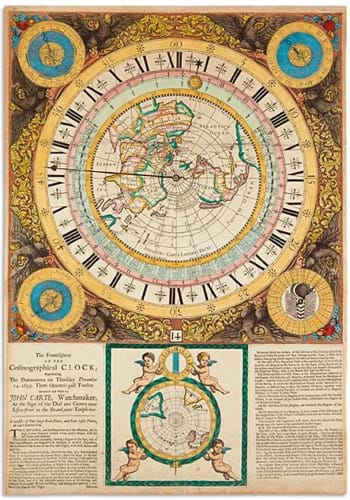That important map, which sold at $100,000 (£76,900), was featured and illustrated as Pick of the Week in ATG No 2397, but two other lots from that Swann (25/20/12% buyer’s premium) sale – a map of Africa and a promotional broadside for a horological invention – feature here.
The Frontispiece of the Cosmographical Clock; Representing the Phoenomena on Thursday December 14, 1699 sold for $12,000 (£9450). It features an invention of John Carte, a London watch maker.
In the broadside’s main image is depicted a 24-hour clock with zodiac rings and a map showing the world on a northern polar projection, while four extra temporal diagrams are seen at each corner. In the lower portion a smaller, cherub adorned map on a southern projection is flanked by two columns of descriptive text.
Two examples of this broadside dated December 3, 1700, are known (in the Yale and BM collections), but no other example of this 1699 version has been traced, said the auction house.
African chart

Almost certainly the work of Petrus Plancius, this rare chart of southern Africa and Madagascar made $70,000 (£56,120).
Estimated at $3000-5000 but sold for $70,000 (£56,120) was a chart of the southern part of Africa and Madagascar.
Published in Amsterdam c.1592-94 by Cornelis Claesz, it is one of a series engraved for him by members of the van Doetecum family. While none actually bear the name of Petrus Plancius as map maker, they are confidently ascribed to him by Gunter Schilder in his Monumenta Cartographia Neerlandica.
These printed charts were the best available to Dutch mariners at the time, but Schilder records only five copies of this particular example – one now lost.
Decorative features include not only a ship besieged by flying fish and a couple of spiky sea monsters, but in the elaborately framed cartouche shipwrecked mariners are seen to be desperately fighting off gigantic lobsters! A Dutch ship, the St Jacobus, was wrecked on rocks between Mozambique and Madagascar in 1586, but whether that inspired the colossal crustacean tales is not known.














